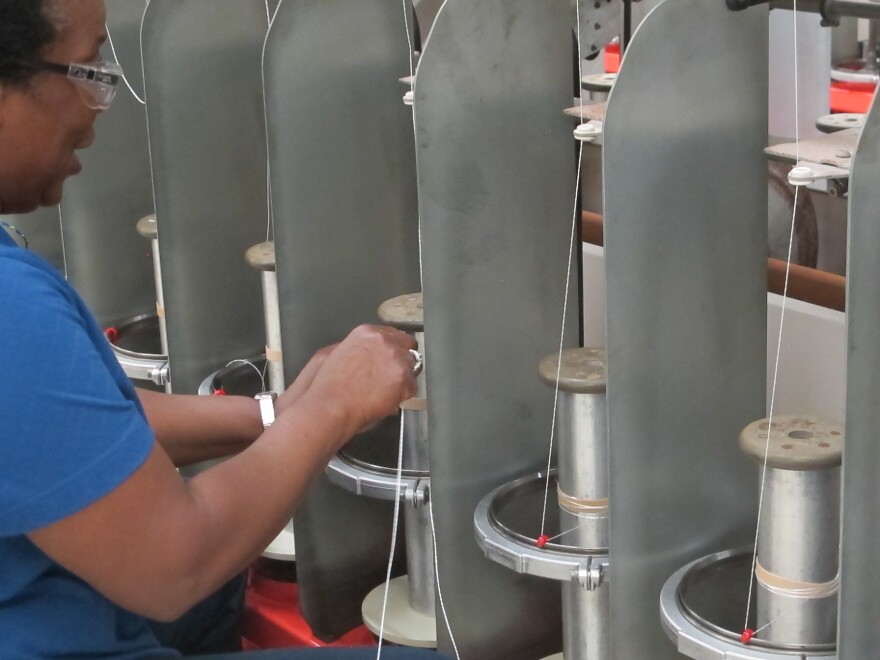A new kind of water contamination has shown up all over the US, including New England. This time it’s not lead, like in the Flint, Michigan water system, but instead it's a chemical used to manufacture Teflon pans, firefighting foam, even microwave popcorn bags. It's forced some communities to hand out bottled water and shut down their water systems.
Although companies have stopped using this chemical because of health worries, a new replacement compound may be toxic, too.
The old chemicals are called “C8s,” because they contain 8 carbons. The most common C8 is PFOA.
Studies funded by a 2005 lawsuit settlement with chemical maker DuPont have shown these chemicals may cause health problems including high cholesterol, kidney cancer, and thyroid disease.
Since last year, American companies aren’t using them anymore -- including Saint-Gobain, a $50 billion dollar plastics company with a plant two and a half miles from Tracy Carl’s house. Right now, Carl and her four kids get all of their water from five-gallon jugs. “We do sometimes drink out of the filtered water from the fridge, which I still don’t trust completely,” she says.
But while researchers still know very little about the toxic C8 compounds, they know even less about the chemicals already being used to replace them.
Inside Saint-Gobain’s Merrimack plastics plant, enormous looms weave fabric from giant spools of glass thread. The fabrics have been used for hazmat suits, military tents and even the roof of AT&T Stadium, home of the Dallas Cowboys. They are incredibly slippery, and impervious even to biological warfare.

Deeper into the plant, I see 25-square-foot tubs of something that looks like paint. It’s called PTFE. This is the coating that gives the fabric that frictionless “repels-everything” quality. It’s the same stuff used on nonstick cookware.
It’s this substance that, up until 2015, contained a C8 toxin. That’s when
U.S companies voluntarily stopped using the chemical, including Saint-Gobain.
So, what, exactly, is in this stuff?
CEO of Saint-Gobain’s Plastics Division, Tom Kinisky won’t say. “That’s confidential between the suppliers,” he says.
Kinisky’s response is less surprising than it may sound. More than 20 percent of all chemicals known to the EPA have confidential names and formulas. Despite that confidentiality agreement, Saint-Gobain has told New Hampshire’s environmental regulator what kind of chemical the replacement is.
Mike Fitzgerald specializes in air quality for the state. He says the C8 chemicals, which are fluorocarbons with 8 carbons, have been replaced with C6s: fluorocarbons with six carbons. They’re safe, he says, “to the extent that we know. We’re certainly relying on the EPA to make sure that they haven’t replaced one chemical with a health and safety threat with another one that is the same or worse.”
As for Tom Kinisky with Saint-Gobain, he says “they’ve all been approved by the EPA.”
But “approved” isn’t the right word. While many of the replacements have been inventoried by EPA, chemicals don’t have to pass any particular safety measures to make it onto that list.
You can blame Congress for that – they wrote law that governs EPA’s chemical rules. It hasn’t been updated in 40 years. “They were rigorously studied,” Kinisky says, “they are regulated materials, unlike what PFOA was.”
This is also not quite right. Rather, the EPA has allowed businesses to use C6s while companies to do their own testing on things like how the chemicals degrade over time, and whether they are toxic.
Saint-Gobain and other companies seem confident in the replacement chemicals.
In the meantime, the EPA tells us by email it is still reviewing the C6s, and considers them to be, “capable of producing reproductive, developmental, and systemic effects in laboratory tests.”
Philippe Grandjean is at the forefront of research on both C8s and their replacements at Harvard University. He says, we know little about C8 chemicals, and even less about C6s. Grandjean says it’s clear C6s can be toxic. “What we really don’t know,” he says, “is what kind of damage they do and at what levels.” In the meantime, Grandjean adds, “the best advice I have is let’s treat them like they have toxic properties like C8.”
Back in Merrimack, Tracy Carl says industry oversight isn’t work. Companies “always ask for forgiveness after the fact, rather than do the research first.”
She says she’s worried the whole C8 water crisis will just become a C6 water crisis, next year.
This story is a production of the New England News Collaborative.







